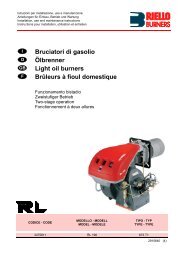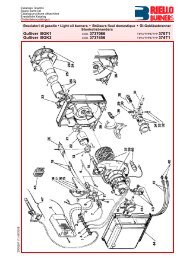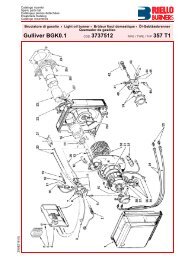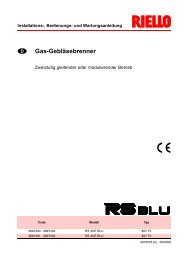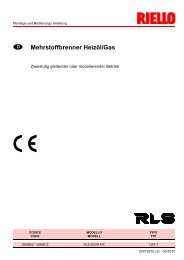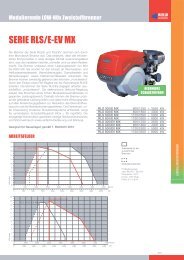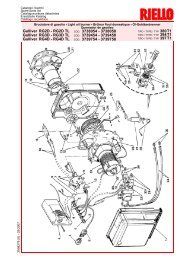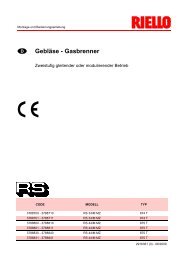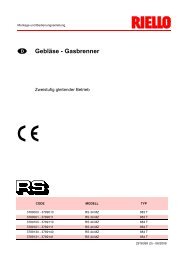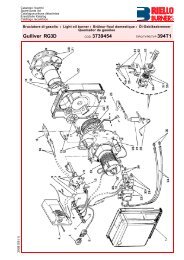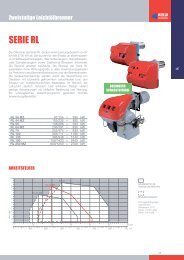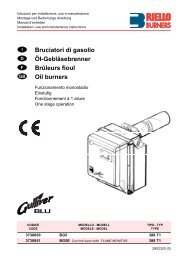Bruciatori di gasolio Öl-Gebläsebrenner Brûleurs fioul Oil burners
Bruciatori di gasolio Öl-Gebläsebrenner Brûleurs fioul Oil burners
Bruciatori di gasolio Öl-Gebläsebrenner Brûleurs fioul Oil burners
- No tags were found...
You also want an ePaper? Increase the reach of your titles
YUMPU automatically turns print PDFs into web optimized ePapers that Google loves.
Istruzioni per installazione, uso e manutenzioneMontage und Be<strong>di</strong>enungs AnleitungManuel d’entretienInstallation, use and maintenance instructionsIDFGB<strong>Bruciatori</strong> <strong>di</strong> <strong>gasolio</strong><strong>Öl</strong>-<strong>Gebläsebrenner</strong><strong>Brûleurs</strong> <strong>fioul</strong><strong>Oil</strong> <strong>burners</strong>Funzionamento monosta<strong>di</strong>oEinstufigFonctionnement à 1 allureOne stage operationCODICECODEMODELLO - MODELLMODELE - MODELTIPO - TYPTYPE3737050 BGK1 370 T13737450 BGK2 374 T12902323 (2)
Dichiarazione del produttore secondo la normativa 1. BImSchV, 1996R.B.L. RIELLO BRUCIATORI LEGNAGO S.p.A. <strong>di</strong>chiara che i seguenti prodotti rispettano ivalori limite degli NOx imposti dalla normativa 1. BImSchV, 1996, § 7 (2):Herstellerbescheinigung gemäß 1. BImSchV, 1996R.B.L. RIELLO BRUCIATORI LEGNAGO S.p.A. bestätigt, daß folgende Produkte, <strong>di</strong>e vonder 1. BImSchV, 1996, § 7 (2) geforderten NOx - Grenzwerte einhalten:Déclaration du producteur selon la <strong>di</strong>rective 1. BImSchV, 1996R.B.L. RIELLO BRUCIATORI LEGNAGO S.p.A. déclare que les brûleurs suivants respectentles valeurs limites de NOx imposées par la <strong>di</strong>rective 1. BImSchV, 1996, § 7 (2):Producer declaration accor<strong>di</strong>ng to 1. BImSchV, 1996R.B.L. RIELLO BRUCIATORI LEGNAGO S.p.A. declares, that the following products complywith the NOx limit values in<strong>di</strong>cated in the 1. BImSchV. 1996 § 7 (2) standard:Prodotto - ProduktreiheProduit - ProductTipo -Typ - TypeModello - AusführungModèle - Model<strong>Bruciatori</strong> <strong>di</strong> <strong>gasolio</strong><strong>Öl</strong>-<strong>Gebläsebrenner</strong><strong>Brûleurs</strong> <strong>fioul</strong><strong>Oil</strong> <strong>burners</strong>370 T1374 T1BGK1BGK2R.B.L. RIELLO BRUCIATORI LEGNAGO S.p.A.2323
INDICE1. DESCRIZIONE DEL BRUCIATORE . . . . . 11.1 Materiale a corredo . . . . . . . . . . . . . . . . . 12. DATI TECNICI . . . . . . . . . . . . . . . . . . . . . 22.1 Dati tecnici . . . . . . . . . . . . . . . . . . . . . . . . 22.2 Dimensioni . . . . . . . . . . . . . . . . . . . . . . . . 22.3 Campo <strong>di</strong> lavoro . . . . . . . . . . . . . . . . . . . . 23. INSTALLAZIONE. . . . . . . . . . . . . . . . . . . 33.1 Fissaggio alla caldaia. . . . . . . . . . . . . . . . 33.2 Alimentazione del combustibile . . . . . . . . 33.3 Impianti idraulici . . . . . . . . . . . . . . . . . . . . 43.4 Collegamenti elettrici . . . . . . . . . . . . . . . . 54. FUNZIONAMENTO. . . . . . . . . . . . . . . . . . 64.1 Regolazione della combustione. . . . . . . . . 64.2 Regolazione elettro<strong>di</strong> . . . . . . . . . . . . . . . . 84.3 Regolazione rivelatore fiamma . . . . . . . . . 84.4 Riscaldamento del combustibile . . . . . . . . 94.5 Programma <strong>di</strong> avviamento . . . . . . . . . . . . 95. MANUTENZIONE . . . . . . . . . . . . . . . . . . . 96. ANOMALIE / RIMEDI . . . . . . . . . . . . . . . .107. NORME GENERALI DI SICUREZZA . . . . 111. DESCRIZIONE DEL BRUCIATOREBruciatore <strong>di</strong> <strong>gasolio</strong> con funzionamento monosta<strong>di</strong>o, a fiamma blu, e quin<strong>di</strong> con basse emissioni inquinanti(Ossi<strong>di</strong> d’Azoto NOx, Ossido <strong>di</strong> carbonio CO e Idrocarburi incombusti).Al fine <strong>di</strong> garantire una combustione col minimo tasso <strong>di</strong> emissioni inquinanti,le <strong>di</strong>mensioni ed il tipo <strong>di</strong> camera <strong>di</strong> combustione del generatore<strong>di</strong> calore, devono corrispondere a valori ben definiti. È pertantoconsigliato consultare il Servizio Tecnico RIELLO prima <strong>di</strong>scegliere questo tipo <strong>di</strong> bruciatore per l’abbinamentocon una caldaia.1 – Pompa olio2 – Gruppo regolazioneserranda aria3 – Gruppo portaugello4 – Flangia con schermo isolante5 – Apparecchiatura <strong>di</strong>comando e controllo6 – Pulsante <strong>di</strong> sblocco consegnalazione <strong>di</strong> blocco7 – Rivelatore fiammaFig. 1S7366■ Approvazione BUWAL n° 198014.■ Il bruciatore risponde al grado <strong>di</strong> protezione IP 40 secondo EN 60529.■ Bruciatore con marcatura CE in conformità alle Direttive CEE: CEM 89/336/CEE, Bassa Tensione 73/23/CEE,Macchine 89/392/CEE e Ren<strong>di</strong>mento 92/42/CEE.1.1 MATERIALE A CORREDOFlangia con schermo isolante. . . . N° 1 Viti e da<strong>di</strong> per flangia <strong>di</strong> fissaggio alla caldaia . . . . N° 2Vite e da<strong>di</strong> per flangia . . . . . . . . . N° 1 Tubi flessibili con nipples . . . . . . . . . . . . . . . . . . . . N° 223231 I
2. DATI TECNICI2.1 DATI TECNICITIPO 370T1 374T1PortataSecondo kg/h 1,5 ¸ 3 2,7 ¸ 5Potenza termica EN 267 kW 17,8 ¸ 35,6 32 ¸ 59,3PortataSecondo kg/h 1,5 ¸ 2,9 2,7 ¸ 3,8Potenza termica LRV 92 kW 17,8 ¸ 34,4 32 ¸ 45Combustibile Gasolio, viscosità max. a 20°C: 6 mm 2 /sAlimentazione elettrica Monofase, 230V ± 10% ~ 50HzMotore 0,85A assorbiti – 2750 g/min – 289 rad/sCondensatore4 mFTrasformatore d’accensione Secondario 8 kV – 16 mAPompa Pressione: 8 ¸ 15 barPotenza elettrica assorbita0,25 kW2.2 DIMENSIONICE A 18910645°1183ø Gø FDB45°83HI140168D5816TIPO A B C D E ø F ø G H I370T1 255 280 202 230 207 ● 104 89 10 28374T1 255 280 202 230 229 105 89 10 28● Ve<strong>di</strong> paragrafo 4.1 pag. 72.3 CAMPO DI LAVORO0,8Pressione in camera <strong>di</strong>combustione – mbarD59020,60,40,20EN 267EN 303-2EN 267LRV 92LRV 92370T1374T11 2 34 5 Portata <strong>di</strong> <strong>gasolio</strong> – kg/h15 20 25 30 35 40 45 50 55 60 Potenza termica – kW23232 I
3. INSTALLAZIONE3.1 FISSAGGIO ALLA CALDAIAATTENZIONELa portina della caldaia deve avere uno spessoremax. <strong>di</strong> 80 mm per BGK1 e 90 mm perBGK2. Rivestimento refrattario compreso.Fig. 2D5012Fig. 4S7263Fig. 3■ Inserire sulla flangia (1) la vite e i due da<strong>di</strong> (ve<strong>di</strong> fig. 3).■ Allargare, se necessario, i fori dello schermo isolante (5) (ve<strong>di</strong> fig. 4).■ Fissare alla portina della caldaia (4) la flangia (1) me<strong>di</strong>ante le viti (2) e (se necessario) i da<strong>di</strong> (3) interponendolo schermo isolante (5) (ve<strong>di</strong> fig. 2).3.2 ALIMENTAZIONE DEL COMBUSTIBILEFig. 512 21D5709Il bruciatore è pre<strong>di</strong>sposto per ricevere i tubi <strong>di</strong> alimentazione del <strong>gasolio</strong> da entrambi i lati.A seconda che l’uscita dei tubi avvenga a destra o a sinistra del bruciatore si dovranno invertire sia lapiastrina <strong>di</strong> fissaggio (1) che la squadretta <strong>di</strong> chiusura (2) (ve<strong>di</strong> fig. 5).23233 I
3.3 IMPIANTI IDRAULICI■ Accertarsi, prima <strong>di</strong> mettere in funzione il bruciatore,che il tubo <strong>di</strong> ritorno del combustibile non abbiaocclusioni. Una eccessiva contropressione provocherebbela rottura dell’organo <strong>di</strong> tenuta della pompa.■ La pompa è pre<strong>di</strong>sposta per funzionamento bitubo.Per il funzionamento monotubo è necessario svitareil dado <strong>di</strong> ritorno (2), togliere la vite <strong>di</strong> by-pass (3) equin<strong>di</strong> riavvitare il dado (2), (ve<strong>di</strong> fig. 7).max. 4 mATTENZIONE:HIMPIANTO NON AMMESSOIN GERMANIA*Fig. 6D5817Hmetri0,511,52ø i8 mm1020406081L metriø i10 mm204080100Fig. 7D50262 3 4 5 6 71 - Aspirazione2 - Ritorno3 - Vite <strong>di</strong> by-pass4 - Attacco manometro5 - Regolatore <strong>di</strong> pressione6 - Attacco vacuometro7 - Valvola8 - Presa <strong>di</strong> pressione ausiliariaINNESCO POMPANell’impianto <strong>di</strong> fig. 6 è sufficiente allentare l’attaccodel vacuometro (6, fig. 7) ed attendere la fuoriuscita del combustibile.Negli impianti <strong>di</strong> fig. 8 e 9 avviare il bruciatore ed attendere l’innesco.Se avviene il blocco prima dell’arrivo del combustibile, attendere almeno20 secon<strong>di</strong>, poi ripetere l’operazione.Non si deve superare la depressione max. <strong>di</strong> 0,4 bar (30 cm Hg).Oltre tale valore si ha liberazione <strong>di</strong> gas dal combustibile. Si raccomanda che letubazioni siano a perfetta tenuta.Negli impianti in depressione si consiglia <strong>di</strong> far arrivare la tubazione <strong>di</strong> ritorno allastessa altezza della tubazione <strong>di</strong> aspirazione. In questo caso non è necessaria lavalvola <strong>di</strong> fondo. Se invece la tubazione <strong>di</strong> ritorno arriva sopra il livello del combustibilela valvola <strong>di</strong> fondo è in<strong>di</strong>spensabile. Questa soluzione è meno sicura dellaprecedente per la possibile mancanza <strong>di</strong> tenuta della valvola.Hmetri00,511,5233,5ø i8 mm353025201586L metriø i10 mm10010010090703020Hmax. 4 mFig. 8 Fig. 9H* *Hmax. 4 mHD5818È necessario installare un filtro sulla linea <strong>di</strong> alimentazione del combustibile*SOLO PER L’ITALIA: Dispositivo automatico <strong>di</strong> intercettazione secondo circolare Ministero dell’interno n° 73 del 29/7/71.H = <strong>di</strong>slivello; L = max. lunghezza del tubo <strong>di</strong> aspirazione; ø i = <strong>di</strong>ametro interno del tubo.23234 I
3.4 COLLEGAMENTI ELETTRICI230V ~ 50HzLNInterruttorecon fusibileATTENZIONENON SCAMBIARE IL NEUTRO CON LA FASE*(Ve<strong>di</strong> pag. 4). Collegare il <strong>di</strong>spositivo automatico<strong>di</strong> intercettazione (230V - 0,5A max.) ai morsettiN - T2 della spina 7 poli.Termostato<strong>di</strong> massima Ta riarmo manualeNeutro6A max.Termostato<strong>di</strong> regolazioneThContaore(230V - 0,1A max.)Segnalazione<strong>di</strong> blocco esterna(230V - 0,1A max.)Spina 7 poliL1NT1T2S3B4ESEGUITO IN FABBRICAPresa 7 poliElettro<strong>di</strong><strong>di</strong> accensioneAPPARECCH.550SEM1 2 31 21 2 31 2 3 4NeroBluMarroneNeroBiancoBluRivelatore fiammaValvola olioMotoreMCondensatoreNeroMarroneS7145BluD5521Riscaldatore con termostato<strong>di</strong> consenso all’avviamentoTerra bruciatoreNOTE:– Sezione dei conduttori 1,5 mm2.– I collegamenti elettrici eseguiti dall’installatore devono rispettare lenorme vigenti nel paese.– Per togliere l’apparecchiatura dal bruciatore allentare la vite (A, fig. 10)dopo aver sconnesso tutti i componenti, la spina a 7 poli ed il filo <strong>di</strong>terra.In caso <strong>di</strong> smontaggio della apparecchiatura riavvitare la vite (A)con una coppia <strong>di</strong> serraggio da 1 ¸ 1,2 Nm.COLLAUDO:Verificare l’arresto del bruciatore aprendo i termostati, ed il bloccooscurando il rivelatore fiamma.S7217Fig. 10A23235 I
4. FUNZIONAMENTO4.1 REGOLAZIONE DELLA COMBUSTIONEIn conformità con la Direttiva Ren<strong>di</strong>mento 92/42/CEE, l’applicazione del bruciatore alla caldaia, laregolazione e il collaudo, devono essere eseguiti nell’osservanza del manuale d’istruzione della caldaiastessa, compreso il controllo della concentrazione <strong>di</strong> CO e CO 2 nei fumi, della loro temperatura e <strong>di</strong> quellame<strong>di</strong>a dell’acqua della caldaia.4A seconda della portata richiesta dalla caldaia vanno definiti: l’ugello, la pressione della pompa e la regolazionedella serranda dell’aria secondo la tabella seguente:TIPO370T1374T1Ugello Pressione Portata Regolazione Regolazionepompa bruciatore testa serranda1 2 3 4GPH Angolo bar kg/h ± 4% Tacca Tacca0,40 60° 12 1,5 0,6 0,10,50 60° 12 1,8 1 0,80,60 60° 12 2,3 2 10,65 60° 12 2,5 2 2,50,75 60° 13 3,0 3 30,75 60° 12 2,8 1,5 1,80,85 60° 12 3,3 1,5 2,11,00 60° 12 3,6 2 2,41,10 60° 12 4,2 2,5 31,25 60° 12 5,0 4 3,55Con i sottocitati ugelli sono statiraggiunti i valori <strong>di</strong> combustionesecondo:RAL-UZ 9, E<strong>di</strong>zione marzo 1997(marchio ambientale - Germania)370T1: Steinen 0,40 GPH - 60° HDelavan 0,75 GPH - 60° W374T1: Delavan 0,75 GPH - 60° WDelavan 1,25 GPH - 60° WLRV 92370T1: Hago 0,40 GPH - 80° HDanfoss 0,75 GPH - 80° HDanfoss 0,75 GPH - 60° H374T1: Hago 0,75 GPH - 60° HSteinen 1,25 GPH - 80° HHago 1,25 GPH - 60° H1UGELLI CONSIGLIATI: Steinen tipo 60° H; Danfoss tipo 60° H; Delavan tipo 60° W.POSIZIONE DI MANUTENZIONEL’accessibilità all’ugello, all’elica ed agli elettro<strong>di</strong> può avvenire in due mo<strong>di</strong>:A Fig. 11 – Estrarre il bruciatore dalla caldaia dopo avere tolto il dado <strong>di</strong> fissaggio alla flangia.– Agganciare il bruciatore alla flangia (1), togliere il tubo fiamma (2) dopo aver allentato le viti (3).– Sfilare i cavetti (4) dagli elettro<strong>di</strong>, estrarre dal gruppo portaugello il gruppo turbolatore (5) dopo averallentato la vite (3, fig. 15, pag. 8).– Avvitare l’ugello (6) correttamente stringendolocome mostrato in figura.Fig. 11S7369S737023236 I
6. ANOMALIE / RIMEDISi elencano alcune cause e i possibili rime<strong>di</strong> a una serie <strong>di</strong> anomalie che potrebbero verificarsi e portare adun mancato o non regolare funzionamento del bruciatore.Un’anomalia, nel funzionamento nella maggior parte dei casi, porta alla accensione della segnalazione all’internodel pulsante <strong>di</strong> sblocco dell’apparecchiatura <strong>di</strong> comando e controllo (pos. 6, fig. 1, pag. 1).All’accendersi <strong>di</strong> questo segnale, il bruciatore potrà funzionare nuovamente solo dopo aver premuto a fondo ilpulsante <strong>di</strong> sblocco; fatto ciò, se avviene un’accensione regolare, si può imputare l’arresto ad una anomaliatransitoria e non pericolosa. Al contrario, se il blocco persiste si dovrà ricercare la causa dell’anomalia e attuarei rime<strong>di</strong> illustrati nella tabella seguente.ANOMALIE POSSIBILE CAUSA RIMEDIOIl bruciatore non partealla chiusura deltermostato <strong>di</strong> regolazione.Il bruciatore rimanein preventilazione.Il bruciatore eseguenormalmente il ciclo<strong>di</strong> preventilazione edaccensione e si bloccadopo circa 5s.Fiamma giallaAvviamento del bruciatorecon ritardo <strong>di</strong>accensione.Manca l’alimentazione elettrica.Riscaldatore o termostati <strong>di</strong> consensoguasti.Le connessioni dell’apparecchiatura elettronicanon sono correttamente inserite.È intervenuto il blocco per mancatospegnimento (evento B pag. 9).il rivelatore fiamma vede luce estranea(led 1 acceso).Il rivelatore fiamma è sporco.Il rivelatore fiamma è <strong>di</strong>fettoso.La fiamma si stacca o non si forma.Ugello sporco o deteriorato.Difetto <strong>di</strong> portata d’aria.Pressione della pompa non taratacorrettamente.Apertura d’aspirazione aria ostruita.Circuito <strong>di</strong> evacuazione fumi ostruito.Gli elettro<strong>di</strong> <strong>di</strong> accensione sono malposizionati.Portata dell’aria troppo elevata.Ugello sporco o deteriorato.Verificare presenza tensione ai morsettiL1 – N della spina 7 poli.Verificare lo stato dei fusibili.Verificare che il termostato <strong>di</strong> massima nonsia in blocco.Provvedere ad una loro sostituzione.Controllare e connettere a fondo tutte leprese.Chiamare il servizio assistenza.Eliminare la fonte <strong>di</strong> luce.Provvedere a una sua pulizia.Provvedere a una sua sostituzione.Controllare la pressione e la portata delcombustibile.Controllare la portata dell’aria.Cambiare ugello.Verificare la bobina dell’elettrovalvola.Provvedere a una sua sostituzione.Regolare la portata dell’aria.Verificare la pressione e la portata del combustibilee regolare secondo quanto in<strong>di</strong>catoin questo manuale.Provvedere a una sua pulizia.Provvedere a una sua pulizia.Provvedere a una corretta regolazionesecondo quanto in<strong>di</strong>cato in questo manuale.Regolare la portata dell’aria secondo quantoin<strong>di</strong>cato in questo manuale.Provvedere a una sua sostituzione.AVVERTENZAÈ esclusa qualsiasi responsabilità contrattuale ed extracontrattuale del costruttore per i danni causati a persone, animali e coseda errori nella installazione e taratura del bruciatore, da un suo uso improprio, erroneo ed irragionevole, da inosservanza delmanuale d’istruzione dato a corredo del bruciatore stesso e dall’intervento <strong>di</strong> personale non abilitato.Il personale abilitato è quello avente i requisiti tecnico professionali in<strong>di</strong>cati dalla legge 5 marzo 1990 n° 46.L’organizzazione commerciale RIELLO <strong>di</strong>spone <strong>di</strong> una capillare rete <strong>di</strong> agenzie e servizi tecnici il cui personale partecipaperio<strong>di</strong>camente a corsi <strong>di</strong> istruzione e aggiornamento presso il Centro <strong>di</strong> Formazione aziendale.232310 I
INDEX1. BESCHREIBUNG DES BRENNERS . . . . 11.1 Mitgeliefertes Zubehör . . . . . . . . . . . . . . . 12. TECHNISCHE MERKMALE. . . . . . . . . . . 22.1 Technische Daten. . . . . . . . . . . . . . . . . . . 22.2 Abmessungen . . . . . . . . . . . . . . . . . . . . . 22.3 Betriebsbereich . . . . . . . . . . . . . . . . . . . . 23. INSTALLATION . . . . . . . . . . . . . . . . . . . . 33.1 Brennermontage . . . . . . . . . . . . . . . . . . . 33.2 Brennstoffversorgung. . . . . . . . . . . . . . . . 33.3 <strong>Öl</strong>versorgungsanlage . . . . . . . . . . . . . . . . 43.4 Elektrisches Verdrahtungsschema . . . . . . 54. BETRIEB . . . . . . . . . . . . . . . . . . . . . . . . . 64.1 Einstellung der Brennerleistung . . . . . . . . 64.2 Elektrodeneinstellung . . . . . . . . . . . . . . . . 84.3 Einstellung des Flammendetektors . . . . . . 84.4 Vorwärmung des Heizöl-EL. . . . . . . . . . . . 94.5 Betriebsablauf. . . . . . . . . . . . . . . . . . . . . . 95. WARTUNG . . . . . . . . . . . . . . . . . . . . . . . . 96. STÖRUNGEN / ABHILFE . . . . . . . . . . . . .101. BESCHREIBUNG DES BRENNERSEinstufiger <strong>Öl</strong>brenner mit blauer Flamme und niedrigem Schadstoffausstoß (Stickoxyde NOx, KohlenmonoxydCO und unverbrannte Kohlenwasserstoffe CmHn).Um bestmögliche Verbrennungs-Ergebnisse sowie niedrige Emissionswerte zu erzielen,muß <strong>di</strong>e Brennkammer-Geometrie des Heizkessels für den Brenner geeignet sein.Deshalb ist es notwen<strong>di</strong>g, vor Einsatz des Brenners Imformationen beiRIELLO einzuholen, um ein einwandfreies Funktionierendes Brenners zu gewährleisten.1 – <strong>Öl</strong>pumpe2 – Luftklappenregulierung3 – Düsenstock4 – Kesselflansch mit Isolier<strong>di</strong>chtung5 – Steuergerät6 – Entstörtaste mit Störanzeige7 – FlammendetektorFig. 1S7366■ Zulassung BUWAL Nr. 198014.■ Der Brenner entspricht der Schutzart IP 40 gemäß EN 60529.■ Brenner mit CE-Kennzeichnung gemäß der EWG-Richtlinien: EMV 89/336/EWG, Niederspannungsrichtlinie73/23/EWG, Maschinenrichtlinie 89/392/EWG und Wirkungsgradrichtlinie 92/42/EWG.1.1 MITGELIEFERTES ZUBEHÖRKesselflansch mit Isolier<strong>di</strong>chtung. . .1 St.Schraube und Muttern für Brenner-Flansch. . . . . . 1 St.<strong>Öl</strong>schläuche mit Anschlußnippel . . .2 St.Schrauben und Muttern für Kesselflansch . . . . . . . 2 St.23231 D
2. TECHNISCHE MERKMALE2.1 TECHNISCHE DATENTYP 370T1 374T1DurchsatzNach kg/h 1,5 ¸ 3 2,7 ¸ 5Feuerungswärmeleistung EN 267 kW 17,8 ¸ 35,6 32 ¸ 59,3DurchsatzNach kg/h 1,5 ¸ 2,9 2,7 ¸ 3,8Feuerungswärmeleistung LRV 92 kW 17,8 ¸ 34,4 32 ¸ 45Brennstoff Heizöl-EL (nach DIN 51603, ÖNORM C1109),max. Viskosität bei 20°C: 6 mm 2 /sStromversorgung Einphase, 230V ± 10% ~ 50HzMotor Stromaufnahme 0,85A – 2750 U/min – 289 rad/sKondensator4 mFZündtransformator Sekundärspannung 8 kV – 16 mAPumpeDruck: 8 ¸ 15 barLeistungsaufnahme0,25 kW2.2 ABMESSUNGENCE A 18910645°1183ø Gø FDB45°83HI140168D5816TYP A B C D E ø F ø G H I370T1 255 280 202 230 207 ● 104 89 10 28374T1 255 280 202 230 229 105 89 10 282.3 BETRIEBSBEREICH● Siehe Abschnitt 4.1 Seite 70,8Druck im Feuerraummbar0,60,40,2EN 267LRV 92370T1EN 267LRV 92374T1EN 303-201 2 34 5 Heizöldurchsatz – kg/hD590215 20 25 30 35 40 45 50 55 60 Brennerleistung – kW23232 D
3. INSTALLATION3.1 BRENNERMONTAGEWICHTIGER HINWEISDie Kesseltür darf mit Isolierung höchstens 80 mmbei BGK1 und 90 mm bei BGK2 <strong>di</strong>ck sein.Abb. 2D5012Abb. 4Abb. 3S7263■ Die Schraube und <strong>di</strong>e beiden Muttern am Flansch (1) montieren (siehe Abb. 3).■ Falls erforderlich, <strong>di</strong>e Bohrungen der Isolier<strong>di</strong>chtung (5) erweitern (siehe Abb. 4).■ Mit den Schrauben (2) und (falls erforderlich) den Muttern (3) den Flansch (1) an der Kesseltür (4) mitIsolier<strong>di</strong>chtung (5) montieren (siehe Abb. 2).3.2 BRENNSTOFFVERSORGUNGAbb. 512 21D5709Die <strong>Öl</strong>schläuche werden mit den Winkelanschlüssen an der <strong>Öl</strong>pumpe montiert, wobei <strong>di</strong>e <strong>Öl</strong>schläuche nachlinks oder nach rechts aus dem Brenner herausgeführt werden können.Es muß jeweils <strong>di</strong>e Halteschelle (1) bzw. der Verschlußwinkel (2) gewechselt werden (siehe Abb. 5).23233 D
3.3 ÖLVERSORGUNGSANLAGEWICHTIGER HINWEIS:■ Es muß sichergestellt werden, daß <strong>di</strong>e <strong>Öl</strong>rücklauf-Leitungohne Verengung und Verstopfung frei in denTank zurückgeführt wird. Durch Druckerhöhung vonmehr als 0,5 bar im Rücklauf wird <strong>di</strong>e <strong>Öl</strong>pumpeun<strong>di</strong>cht.■ Die Pumpe ist werksseitig für den Zweirohr-Betriebeingerichtet. Wird ein Pumpen-Einrohrbetrieb fürnotwen<strong>di</strong>g erachtet, so ist <strong>di</strong>e Rücklauf-Schlauchleitungsmutter(2) zu lösen und <strong>di</strong>e By-Pass Schraube(3) zu entfernen. Danach ist <strong>di</strong>e Rücklauf-Schlauchleitungsmutterwieder anzuschließen (siehe Abb. 7).max. 4 mHIN DEUTSCHLAND NICHTZULÄSSIGE ANLAGE*Abb. 6D5817HMeter0,511,5281ø i8 mm10204060Abb. 7D50262 3 4 5 6 7L Meterø i10 mm204080100AUFFÜLLEN DER PUMPE MIT HEIZÖL:Bei der in Abb. 6 dargestellten Anlage ist es ausreichend, wenn man denVakuummeteranschluß (6, Abb. 7) lockert und das Austreten des Brennstoffesabwartet.Bei den in Abb. 8 und in Abb. 9 dargestellten Anlagen den Brenner starten unddas Auffüllen abwarten. Sollte vor Eintritt des Brennstoffes eine Störabschaltungerfolgen, mindestens 20 Sekunden warten und danach den Vorgang wiederholen.Der max. Unterdruck in der Saugleitung von 0,4 bar (30 cm Hg) darf nicht unterschrittenwerden. Unter <strong>di</strong>esem Wert bilden sich im Brennstoff Gase. Sichunbe<strong>di</strong>ngt vergewissern, daß <strong>di</strong>e Leitungen absolut <strong>di</strong>cht sind.Bei den Anlagen nach Abb. 9, empfehlen wir, <strong>di</strong>e <strong>Öl</strong>rücklauf-Leitung in gleicherHöhe wie <strong>di</strong>e Saugleitung im Tank enden zu lassen. Es kann auf ein Fußventil inder Saugleitung verzichtet werden. Endet <strong>di</strong>e Rücklauf-Leitung über dem<strong>Öl</strong>niveau wird auf der Saugseite zwingend ein Fußventil benötigt, wobei <strong>di</strong>esesdann bei Verschmutzung Probleme verursachen kann.1 – Saugleitung2 – Rücklaufleitung3 – By-pass schraube4 – Manometeranschluß5 – Druckregler6 – Vakuummeteranschluß7 – <strong>Öl</strong>magnetventil8 – HilfsdruckanschlußHMeter00,511,5233,5ø i8 mm353025201586L Meterø i10 mm10010010090703020Hmax. 4 mFig. 8 Fig. 9H* *max. 4 mHHD5818In der Brennstoff–Ansaugleitung muß ein Filter eingebaut werden.NUR FÜR ITALIEN: automatische Absperrung gemäß Rundschreiben des Innenministeriums Nr. 73 vom 29.7.71.*H = Höhenunterschied; L = max. Länge der Saugleitung; ø i = Innendurchmesser der Leitung.23234 D
3.4 ELEKTRISCHES VERDRAHTUNGSSCHEMA230V ~ 50HzLNSchalter mitSicherungWICHTIGER HINWEIS NULLEITER NICHTMIT DER PHASE VERWECHSELN*(Siehe Seite 4). Die automatische Absperrung(230V - 0,5A max.) an den N – T2 Klemmendes 7– poliges Steckers anschliessen.6A max.hBetriebsstundenzähler(230V - 0,1A max.)Sicherheits-Temperatur-BegrenzerTNulleiterRegelthermostatTExterne Störlampe(230V - 0,1A max.)7–poliger SteckerL1NT1T2S3B47–polige SteckdoseWERKSSEITIGE EINSTELLUNGZündelektrodenSTEUERGERÄT550SEM1 2 31 21 2 31 2 3 4SchwarzBlauBraunSchwarzWeißBlauFlammendetektorMotorM<strong>Öl</strong>ventilKondensatorSchwarzBraunS7145Vorwärmer mitStartfreigabethermostatBlauD5521Brenner-ErdungANMERKUNGEN:– Leiterdurchmesser 1 mm 2 .– Die vom Installateur ausgeführten elektrischen Verbindungen müssen denLokalen Bestimmungen entsprechen.– Um das Steuergerät vom Brenner abnehmen zu können, müssen <strong>di</strong>eSteckverbindungen zu allen Komponenten, der 7– polige Steckersowie das Erdungskabel und dann <strong>di</strong>e Schraube (A, Abb. 10) gelöstwerden.Falls das Steuergerät ausgebaut wird, <strong>di</strong>e Schraube (A) mit einemAnziehmoment von 1 ¸ 1,2 Nm wieder anschrauben.PRÜFUNG:Die Regelabschaltung des Brenners kann man überprüfen, indem man<strong>di</strong>e Thermostate öffnet. Die Störabschaltung kann man überprüfen,indem man den Flammendetektor verdunkelt.S7217Abb. 10A23235 D
4. BETRIEB4.1 EINSTELLUNG DER BRENNERLEISTUNGIn Konformität mit der Wirkungsgradrichtlinie 92/42/EWG müssen <strong>di</strong>e Anbringung des Brenners am Heizkessel,<strong>di</strong>e Einstellung und <strong>di</strong>e Inbetriebnahme unter Beachtung der Betriebsanleitung der Heizkessels ausgeführtwerden, einschließlich Kontrolle der Konzentration von CO und CO 2 in den Abgasen, ihrer Temperatur und dermittlenen Kesseltemperatur.Entsprechend der gewünschten Kesselleistung werden Düse, Pumpendruck und Luftklappeneinstellunggemäß folgender Tabelle bestimmt:TYP370T1374T1Düse Pumpen- Brenner- Brennerkopf- Luftklappen-Druck Durchsatz Einstellung Einstellung1 2 3 4GPH Winkel bar kg/h ± 4% Rastepunkt Rastepunkt0,40 60° 12 1,5 0,6 0,10,50 60° 12 1,8 1 0,80,60 60° 12 2,3 2 10,65 60° 12 2,5 2 2,50,75 60° 13 3,0 3 30,75 60° 12 2,8 1,5 1,80,85 60° 12 3,3 1,5 2,11,00 60° 12 3,6 2 2,41,10 60° 12 4,2 2,5 31,25 60° 12 5,0 4 3,55Mit den untengenannten Düsenwurden Verbrennungswerteerreicht nach:RAL-UZ 9, Ausgabe März 1997370T1: Steinen 0,40 GPH - 60° HDelavan 0,75 GPH - 60° W374T1: Delavan 0,75 GPH - 60° WDelavan 1,25 GPH - 60° WLRV 92370T1: Hago 0,40 GPH - 80° HDanfoss 0,75 GPH - 80° HDanfoss 0,75 GPH - 60° H374T1: Hago 0,75 GPH - 60° HSteinen 1,25 GPH - 80° HHago 1,25 GPH - 60° H1EMPFOHLENE DÜSEN: Steinen Typ 60° H; Danfoss Typ 60° H; Delavan Typ 60° W.WARTUNGSSTELLUNGDIE ZUGÄNGLICHKEIT DER DÜSE, DER STAUSCHEIBE UND DEN ELEKTRODEN WIRD DURCH FOL-GENDE VORGEHENSWEISE ERLEICHTERT:A Abb. 11 –Den Brenner vom Kessel abnehmen, zuvor <strong>di</strong>e Befestigungsmutter vom Flansch abschrauben.– Den Brenner an dem Flansch (1) hängen, das Flammendruckrohr (2) wegnehmen, nachdem man vorher <strong>di</strong>eSchrauben (3) gelockert hat.– Die Zündkabel (4) von den Elektroden abziehen, den Stauscheibenhalter-System (5) vom Düsenstockherausnehmen, nachdem <strong>di</strong>e Befestigungsschraube (3, Abb. 15, Seite 8) gelockert wurde.– Die Düse (6) richtig anschrauben, wie inder Abbildung dargestellt.Abb. 11S7369S737023236 D
B Abb. 12 – Den Düsenstock (1) herausnehmen,nachdem vorher <strong>di</strong>e Schrauben (2)gelockert, <strong>di</strong>e Mutter (3) gelöst, <strong>di</strong>e Zündkabel(4) vom Steuergerät, <strong>di</strong>e Steckdose (5)und den Flammendetektor (6) abgenommenwurden.– Die Zündkabel (4) von den Elektroden abnehmen,den Stauscheibenhalter-System (7) vomDüsenstock (1) herausnehmen, nachdem <strong>di</strong>eSchraube (3, Abb.15, Seite 8) gelockert wurde.– Die Düse (8) richtig anschrauben, wie abgebildet.Achtung: Bei der Wiedermontage des Düsenstockes<strong>di</strong>e Mutter (3) anschraubenwie in Abb. 13 dargestellt.2 PUMPENDRUCK– Wird werksseitig auf 12 bar eingestellt.Veränderungen werden mit Hilfe derSchraube (5, Abb. 7, S. 4) vorgenommen.3 BRENNERKOPFEINSTELLUNG(siehe Abb. 12)Sie ist vom <strong>Öl</strong>durchsatz abhängig und wird ausgeführt,indem man <strong>di</strong>e Einstellschraube (9) imUhrzeigersinn oder entgegen dem Uhrzeigersinnsoweit dreht, bis <strong>di</strong>e auf der Einstellspindelmarkierte Raste (10) mit der Kante am Düsenstock(1) übereinstimmt.– In der Abbildung ist der Brennkopf auf einenDurchsatz von 0,75 GPH bei 13 bar bezüglichauf des Brenners BGK1 Typ 370 T1 eingestellt.Die Raste 3 der Einstellspindel stimmtmit der äußeren Ebene des Düsenstocksüberein, wie in der Tabelle angegeben.E FLAMMENROHREINSTELLUNG BGK1(siehe Abb. 14)Das Flammenrohr ist ab Werk auf Stellung 1eingestellt.Falls nötig, kann das Flammenrohr je nachBrennraum gemäß Tabelle eingestellt werden,um <strong>di</strong>e Verbrennung zu optimieren.Abb. 12Abb. 133D5684S7368ANZIEHEN, OHNE BIS ZUMANSCHLAG AUSZUFAHREN4 LUFTKLAPPENEINSTELLUNG(siehe Abb. 12)– Die Einstellung erfolgt mit Hilfe der Schraube(11), nachdem man vorher <strong>di</strong>e Mutter (12) gelockerthat .– Die in der Tabelle aufgeführten Werte geltenbei 13% CO2 auf Meereshöhe.– Bei Brennerstillstand schließt <strong>di</strong>e Luftklappeautomatisch, bis zu einem max. Unterdruckim Schornstein von 0,5 mbar.Abb. 14EStell. 1 2 3mm 207 189,5 172ED592423237 D
5 BEMERKUNG (RAL-UZ 9 DEUTSCHLAND)– Ein Betriebsstundenzähler zur Ermittlung des Jahresnutzungsgrades und zur Abstimmung des Heizkesselsauf den Wärmebedarf wird empfohlen.– Ein Abgasthermometer, das Hinweise auf <strong>di</strong>e Verschmutzung der Heizflächen und auf eine falsche Brennereinstellunggeben kann, wird empfohlen.➤Voraussetzung für <strong>di</strong>e einwandfreie Funktion der Feuerungsanlage ist der richtig <strong>di</strong>mensionierte Schornstein.Die Dimensionierung erfolgt nach DIN 4705 auf Basis der Abgaswerte aus der techn. Datentabelle.➤Der Brenner darf nur an einem Heizkessel verwendet werden, wenn <strong>di</strong>e Wärmeleistung des Heizkessels denLeistungsbereich des <strong>Öl</strong>brenners nicht überschreitet und der Druck im Feuerraum <strong>di</strong>e im Arbeitsfeld desBrenners festgelegten Grenzwerte nicht überschritten werden.4.2 ELEKTRODENEINSTELLUNG (siehe Abb. 15)WICHTIGER HINWEISSetzen den Stauscheibenhalter-System (1) wie in Abbildung abgebildet.Für eventuelle Einstellungen <strong>di</strong>e Schraube (2) lösen und das Elektrodenpaar (4) verstellen.Um Zugang zu den Elektroden zu erhalten, <strong>di</strong>e im Kapitel 4.1 unter dem Stichpunkt “EMPFOHLENEDÜSEN” (S. 6) beschriebene Anleitung befolgen.WICHTIGER HINWEISAbb. 15DIE ABSTÄNDE MÜSSEN EINGEHALTEN WERDEN04,5 – 0,5 mm245,5 ± 0,3 mmD58433 1+ 0,54 0 mm4.3 EINSTELLUNGDES FLAMMENDETEKTORS (Siehe Abb. 16)Die Empfindlichkeit des Flammendetektors kann mit dem Potentiometer(3) reguliert werden. Werksseitig ist er auf Stellung 4 eingestellt.Die LED-Anzeige (1) zeigt <strong>di</strong>e optimale Empfindlichkeit.Die LED-Anzeige (2) zeigt den Betrieb.■ Während der Vorbelüftung leuchtet keine LED-Anzeige.■ Die optimale Empfindlichkeit wird durch Aufleuchten beiderLED-Anzeigen signalisiert.➤ Wenn <strong>di</strong>e LED-Anzeige (1) flackert, das Potentiometer im Uhrzeigersinndrehen, bis sie stän<strong>di</strong>g aufleuchtet, dann den Zeigergegen den Uhrzeigersinn drehen, bis <strong>di</strong>e LED flackert.Danach <strong>di</strong>e Empfindlichkeit durch Verstellen des Potentiometersum eine oder zwei Kerben im Uhrzeigersinn erhöhen.➤ Nach mindestens 5 Minuten Stillstand prüfen, ob <strong>di</strong>e so ausgeführteEinstellung ein korrektes Anfahren des Brennerserlaubt.Abb. 16S712932123238 D
4.4 VORWÄRMUNG DES HEIZÖL–ELUm auch bei niedrigen Heizöl–Temperaturen eine ordnungsgemäße Zündung zu ermöglichen, ist der Brennermit einer <strong>Öl</strong>vorwärmung ausgestattet.Ein Thermostat in der <strong>Öl</strong>vorwärmung gibt den Brenner erst bei einer Heizöltemperatur von 70°C frei und einzusätzlich eingebauter PTC–Widerstand sorgt für eine gleichbleibende <strong>Öl</strong>temperatur.Die Vorwärmung bleibt während des Betriebs eingeschaltet und schaltet sich bei Brennerstillstand aus.4.5 BETRIEBSABLAUFThermostatVorwärmerMotorZündtransformatorVentilFlammeStörlampeStörabschaltungwegen nicht erfolgterZündungNormal0¸150s~12sStörabschaltung wegenNichtzündung AStörabschaltungwegen Nichtabschaltens0¸150s ~12s 0¸150s ~12s 20¸60s5sBD5197ABWird durch <strong>di</strong>e Kontrollampe am Steuer- und Überwachungsgerät signalisiert (6, Abb. 1, S. 1).In <strong>di</strong>esem Fall fährt der Brenner nicht wieder an, da eine besonders schwerwiegende Störung vorliegt.DEN KUNDENDIENST RUFENDER AUTORISIERTE KUNDENDIENST MUß ZUERST DIE FUNKTION FOLGENDER EINRICHTUNGENÜBERPRÜFEN:■ Flammendetektor (7, Abb. 1, S. 1).■ Pumpe: <strong>Öl</strong>magnetventil (7) oder Kolben des Druckreglers (5), siehe Abb. 7, S. 4.DIE STÖRABSCHALTUNG KANN MIT HILFE EINES ENTSPRECHENDEN WERKZEUGS DURCH DIE AMBODEN DES STEUERGERÄTES BEFINDLICHE AUSSPARUNG BESEITIGT WERDEN.5. WARTUNGDer Brenner muß in regelmäßigen Zeitabständen vom Kunden<strong>di</strong>enst gewartet werden.Die Wartung ist für den umweltfreundlichen Betrieb des Brenners unbe<strong>di</strong>ngt notwen<strong>di</strong>g. Es wird dadurchsichergestellt, daß bestmögliche Energie-Verbrauchswerte erreicht werden, was mit einer Schadstoff-Reduzierunggleichzusetzten ist. Vor jeder Wartungsarbeit den Brenner stromlos schalten.WICHTIGSTE WARTUNGSARBEITEN:■ Überprüfen, ob <strong>di</strong>e <strong>Öl</strong>versorgungsleitung und <strong>di</strong>e Rücklaufleitung weder verstopft noch geknickt sind.■ Filter in der Versorgungsleitung und an der Pumpe reinigen.■ Korrekten Brennstoffverbrauch überprüfen.■ <strong>Öl</strong>düse austauschen.■ Brennkopf und Stauscheibe reinigen.■ Brenner ca. 10 Minuten auf voller Leistung laufen lassen, alle in <strong>di</strong>esem Handbuch aufgeführten Elementekorrekt einstellen. Danach Abgasanalyse erstellen:● Abgastemperatur; ● CO 2 - Gehalt (%); ● CO-Gehalt (ppm); ● Rußtest.23239 D
6. STÖRUNGEN / ABHILFENachfolgend finden Sie einige denkbare Ursachen und Abhilfemöglichkeiten für Störungen, <strong>di</strong>e den Betriebdes Brenners beeinflussen oder einen nicht ordnungsgemäßen Betrieb des Brenners verursachen könnten.In den meisten Fällen führt eine Störung zum Aufleuchten der Kontrolleuchte in der Entstörtaste des Steuergeräts(Pos. 6, Abb. 1, S. 1).Beim Aufleuchten <strong>di</strong>eses Signals kann der Brenner erst nach Drücken der Entstörtaste wieder in Betriebgesetzt werden. Wenn anschließend eine normale Zündung erfolgt, so war <strong>di</strong>e Störabschaltung auf einevorübergehende, ungefährliche Störung zurückzuführen.Wenn hingegen <strong>di</strong>e Störabschaltung weiterhin fortbesteht, so sind <strong>di</strong>e Ursachen der Störung und <strong>di</strong>e entsprechendenAbhilfemaßnahmen folgender Tabelle zu entnehmen:STÖRUNGEN MÖGLICHE URSACHE ABHILFEBei Wärmeanforderungläuft der Brenner nichtan.Der Brenner bleibt inder Vorbelüftungsphase.Der Brenner führt denVorbelüftungs-und Zündzyklusregulär aus; nachungefähr 5 Sekunden erfolgteine Störabschaltung.Gelbe FlammeAnfahren des Brennersmit verspäteterZündung.Keine Stromzufuhr.Vorwärmung oderFreigabethermostate defekt.Die Verbindungen des Steuergerätessind nicht richtig eingesteckt.Es ist eine Störabschaltung wegenfehlender Abschaltung erfolgt.(Ereignis B, S. 9).Der Flammendetektor meldet Fremdlicht(LED-Anzeige 1 aufleuchtet).Der Flammendetektor ist verschmutzt.Der Flammendetektor ist defekt.Die Flamme reißt ab oder bildetsichnicht.Verschmutzte oder defekte Düse.Luftdurchsatz fehlerhaft.Pumpendruck nicht korrekt eingestellt.Luftzufuhröffnung verschmutzt.Kessel verschmutzt.Zündelektroden nicht in richtigerPosition.Zu hoher Luftdurchsatz.Verschmutzte oder defekte Düse.Spannung zwischen den Klemmen L1 - Ndes 7- poligen Steckers prüfen.Sicherungen überprüfen.Überprüfen, ob der max.- Thermostatnicht auf Störabschaltung steht.Austauschen.Sämtliche Steckverbindungen überprüfenund bis zum Anschlag einstecken.Kunden<strong>di</strong>enst rufen.Lichtquelle beseitigen.Reinigen.Austauschen.Brennstoffdruck und- Durchsatzüberprüfen.Luftdurchsatz überprüfen.Düse wechseln.Magnetventilspule überprüfen.Austauschen.Luftdurchsatz nachregulieren.Brennstoffdruck und -Durchsatz überprüfenund gemäß den Angaben <strong>di</strong>eser Anleitungeinstellen.ReinigenReinigenGemäß den Angaben <strong>di</strong>eser Anleitungkorrekt einstellen.Gemäß den Angaben <strong>di</strong>eser Anleitungden Luftdurchsatz korrekt einstellen.Austauschen.WICHTIGER HINWEIS:Jegliche vertragliche und außervertragliche Haftung des Herstellers für Schäden an Personen, Tieren undSachen, <strong>di</strong>e durch Fehler bei der Installation und Einstellung des Brenners, durch unsachgemäßen, falschenund unvernünftigen Gebrauch desselben, durch Nichtbeachtung der mitgelieferten Be<strong>di</strong>enungsanleitungund durch das Eingreifen von unbefugtem Personal verursacht werden, ist ausgeschlossen.232310 D
SOMMAIRE1. DESCRIPTION DU BRULEUR. . . . . . . . . 11.1 Matériel fourni . . . . . . . . . . . . . . . . . . . . . 12. DONNEES TECHNIQUES . . . . . . . . . . . . 22.1 Données techniques . . . . . . . . . . . . . . . . 22.2 Dimensions . . . . . . . . . . . . . . . . . . . . . . . 22.3 Plages de travail . . . . . . . . . . . . . . . . . . . 23. INSTALLATION. . . . . . . . . . . . . . . . . . . . 33.1 Fixation à la chau<strong>di</strong>ère. . . . . . . . . . . . . . . 33.2 Alimentation du combustible . . . . . . . . . . 33.3 Installation hydraulique . . . . . . . . . . . . . . 43.4 Raccordements électriques . . . . . . . . . . . 54. FONCTIONNEMENT . . . . . . . . . . . . . . . . 64.1 Réglage de la combustion. . . . . . . . . . . . . 64.2 Réglage des électrodes . . . . . . . . . . . . . . 84.3 Réglage détecteur flamme . . . . . . . . . . . . 84.4 Réchauffage du combustible. . . . . . . . . . . 94.5 Programme de mise en marche . . . . . . . . 95. ENTRETIEN . . . . . . . . . . . . . . . . . . . . . . . 96. PANNES / REMEDES. . . . . . . . . . . . . . . .101. DESCRIPTION DU BRULEURBrûleur de <strong>fioul</strong> à fonctionnement à une allure, flamme bleue, soit basses émissions de polluants(Oxyde d’Azote NOx, Oxyde de Carbone CO et Hydrocarbures imbrûlés).Afin de garantir une combustion avec le minimum taux des émissions polluantes,les <strong>di</strong>mensions et le type de chambre de combustion du générateurdoivent correspondre à des valeurs bien déterminées. Il est doncconseillé de consulter le Service Technique RIELLO avantde choisir ce type de brûleur pour l’équipement d’unechau<strong>di</strong>ère.1 – Pompe <strong>fioul</strong>2 – Réglage du volet d’air3 – Porte gicleur4 – Bride avec joint isolant5 – Boîte de commande et decontrôle6 – Bouton de réarmement avecsignalisation de sécurité7 – Détecteur flammeFig. 1S7366■ Approbation BUWAL N° 198014.■ Brûleur conforme au degré de protection IP 40 selon EN 60529.■ Brûleur avec label CE conformément aux <strong>di</strong>rectives CEE: EMC 89/336/CEE, Basse Tension 73/23/CEE,Machines 89/332/CEE et rendement 92/42/CEE.1.1 MATERIEL FOURNIBride avec joint isolant . . . . . . . . . N° 1 Vis et écrous pour bride de montage sur la chau<strong>di</strong>ère . N° 2Vis et écrous pour bride . . . . . . . . N° 1 Flexibles avec nipples . . . . . . . . . . . . . . . . . . . . . . . . . N° 223231 F
2. DONNEES TECHNIQUES2.1 DONNEES TECHNIQUESTYPE 370T1 374T1DébitSelon kg/h 1,5 ¸ 3 2,7 ¸ 5Puissance thermique EN 267 kW 17,8 ¸ 35,6 32 ¸ 59,3DébitSelon kg/h 1,5 ¸ 2,9 2,7 ¸ 3,8Puissance thermique LRV 92 kW 17,8 ¸ 34,4 32 ¸ 45CombustibleFioul domestique, viscosité max. a 20°C: 6 mm2/sAlimentation électrique Monophasée, 230V ± 10% ~ 50HzMoteur 0,85A absorbés – 2750 t/min – 289 rad/sCondensateur4 mFTransformateur d’allumage Secondaire 8 kV – 16 mAPompe Pression: 8 ¸ 15 barPuissance électrique absorbée0,25 kW2.2 DIMENSIONSCE A 18910645°1183ø Gø FDB45°83HI140168D5816TYPE A B C D E ø F ø G H I370T1 255 280 202 230 207 ● 104 89 10 28374T1 255 280 202 230 229 105 89 10 28● Voir paragraphe 4.1 page 72.3 PLAGES DE TRAVAILPression dans a chambre decombustion – mbarD59020,80,60,40,20EN 267EN 303-2EN 267LRV 92LRV 92370T1374T11 2 34 5 Débit <strong>fioul</strong> – kg/h15 20 25 30 35 40 45 50 55 60 Puissance thermique – kW23232 F
3. INSTALLATION3.1 FIXATION A LA CHAUDIEREIMPORTANTLa plaque de la chau<strong>di</strong>ère doit avoir une épaisseurmaximum de 80 mm pour BGK1 et 90 mm pourBGK2. Habillage refractaire compris.Fig. 2D5012Fig. 4Fig. 3S7263■ Insérer sur la bride (1) la vis et deux écrous, (voir fig. 3).■ Elargir, si nécessaire, les trous dans le joint isolant (5), (voir fig. 4).■ Fixer sur la plaque de la chau<strong>di</strong>ère (4) la bride (1) par l’intermé<strong>di</strong>aire des vis (2) et (si nécessaire) desécrous (3) en interposant le joint isolant (5), (voir fig. 2).3.2 ALIMENTATION DU COMBUSTIBLEFig. 512 21D5709Le brûleur est prééquipé pour recevoir les tubes d’alimentation du <strong>fioul</strong> des deux cotés.Selon que la sortie des flexibles est à droite ou à gauche, il peut y avoir lieu de changer l’emplacement dela plaque de fixation (1) avec celle d’obturation (2), (voir fig. 5).23233 F
3.3 INSTALLATION HYDRAULIQUEIMPORTANT:■ Avant de mettre en fonction le brûleur il faut s’assurerque le tube de retour du combustible ne soit pasobstrué. Une contre-pression excessive provoqueraitla rupture de l’organe d’étanchéité de la pompe.■ La pompe est prévue pour un fonctionnement enbitube. Pour le fonctionnement en mono-tube, il fautdévisser l’écrou de retour (2), enlever la vis de bypass(3) et ensuite revisser l’écrou (2), (voir fig. 7).81D5026Fig. 7max. 4 mINSTALLATION EN MONO-TUBE PAR GRAVITE(NON AUTORISEE EN ALLEMAGNE)H*Fig. 6D5817Hmètresø i8 mmL mètresø i10 mmAMORÇAGE DE LA POMPE:Dans l’installation en fig. 6, il faut desserrerle raccord du vacuomètre (6, fig. 7) jusqu’à la sortie du combustible.Dans les installations en fig. 8 et 9, mettre en marche le brûleur etattendre l’amorçage.Si la mise en sécurité se produit avant l’arrivée du combustible, attendre aumoins 20 secondes, puis recommencer cette opération.Il ne faut pas dépasser la dépression max. de 0,4 bar (30 cm Hg).Au-dessus de cette valeur, il y a dégazage du combustible.Les tuyauteries doivent être parfaitement étanches.Dans les installations par dépression la tuyauterie de retour doit arriver à lamême hauteur que celle d’aspiration. Dans ce cas il n’y a pas besoin de clapetde pied. Dans le cas contraire, le clapet de pied est in<strong>di</strong>spensable.Cette deuxième solution est moins sûre que la précédente en raison du manqued’étanchéité éventuel de ce clapet.0,511,52102040602 3 4 5 6 72040801001 - Aspiration2 - Retour3 - Vis de by-pass4 - Raccord manomètre5 - Régulateur de pression6 - Raccord vacuomètre7 - Vanne8 - Prise de pression auxiliaireHmètres00,511,5233,5ø i8 mm353025201586L mètresø i10 mm10010010090703020Hmax. 4 mFig. 8 Fig. 9HHmax. 4 mH* *D5818Il est nécessaire d’installer un filtre sur la ligne d’alimentation du combustible.SEULEMENT POUR L’ITALIE: Dispositif automatique d’arrêt selon circulaire du Ministère de l’intérieur n° 73 du 29/7/71.H * = <strong>di</strong>fférence de niveau; L = longueur maximum du tube d’aspiration; ø i = <strong>di</strong>amètre interne du tube.23234 F
3.4 RACCORDEMENTS ELECTRIQUES230V ~ 50HzLNInterrupteuravec fusibleATTENTIONNE PAS INVERSER LE NEUTRE AVEC LA PHASE*(Voir page 4). Brancher le <strong>di</strong>spositif automatiqued’arrêt (230V - 0,5A max.) au bornier N - T2 de lafiche 7 pôles.Thermostatmaxi avec Tréarmement manuelNeutre6A max.Thermostat deréglageThCompteur horaire(230V - 0,1A max.)Signalisation de sécurité extérieure(230V - 0,1A max.)Fiche 7 pôlesL1NT1T2S3B4REALISE EN USINEPrise 7 pôlesElectrodesd’allumagesBOITEDE CONTROLE550SEM1 2 31 21 2 31 2 3 4NoirBleuMarronNoirBlancBleuDétecteur flammeVanne <strong>fioul</strong>MoteurMCondensateurS7145BleuNoirMarronDispositif de préchauffage avecthermostat pour mise en marcheD5521Terre brûleurNOTES:– Section conducteurs 1 mm2.– Les branchements électriques exécutés par l’installateur doiventrespecter le règlement en vigueur dans le Pays.– Pour enlever la boîte de contrôle du brûleur, dévisser la vis (A, fig. 10)après avoir débranché tous les composants, la fiche 7 pôles et le filde terre.Au remontage, revisser la vis (A) avec une couple de serrage de1 ¸ 1,2 Nm.VERIFICATION:Vérifier que le brûleur se met en sécurité à l’ouverture des thermostatset en ocultant le détecteur flamme.S7217Fig. 10A23235 F
4. FONCTIONNEMENT4.1 REGLAGE DE LA COMBUSTIONConformément à la Directive rendement 92/42/CEE, suivre les in<strong>di</strong>cations du manuel de la chau<strong>di</strong>ère pourmonter le brûleur, effectuer le réglage et l’essai, contrôler la concentration de CO et CO 2 , dans les fumées, leurtempérature et celle moyenne de l’eau de la chau<strong>di</strong>ère.Selon le débit voulu par la chau<strong>di</strong>ère, il faut déterminer le gicleur, la pression 4de la pompe et le réglage duvolet d’air selon le tableau ci-dessous:TYPE370T1374T1Gicleur Pression Débit Réglage tête Réglagepompe brûleur combustion volet d’air1 2 3 4GPH Angle bar kg/h ± 4% Repère Repère0,40 60° 12 1,5 0,6 0,10,50 60° 12 1,8 1 0,80,60 60° 12 2,3 2 10,65 60° 12 2,5 2 2,50,75 60° 13 3,0 3 30,75 60° 12 2,8 1,5 1,80,85 60° 12 3,3 1,5 2,11,00 60° 12 3,6 2 2,41,10 60° 12 4,2 2,5 31,25 60° 12 5,0 4 3,55Avec les gicleurs ci-dessous lesvaleurs de combustion sontatteintes selon:RAL-UZ 9, E<strong>di</strong>tion Mars 1997(marque d’ambiance - Allemagne)370T1: Steinen 0,40 GPH - 60° HDelavan 0,75 GPH - 60° W374T1: Delavan 0,75 GPH - 60° WDelavan 1,25 GPH - 60° WLRV 92370T1: Hago 0,40 GPH - 80° HDanfoss 0,75 GPH - 80° HDanfoss 0,75 GPH - 60° H374T1: Hago 0,75 GPH - 60° HSteinen 1,25 GPH - 80° HHago 1,25 GPH - 60° H1GICLEURS CONSEILLES: Steinen type 60° H; Danfoss type 60° H; Delavan type 60° W.POSITION D’ENTRETIENL’ACCESSIBILITE AU GICLEUR, A L’ACCROCHE FLAMME ET AUX ELECTRODES PEUT ETRE REALISEDE DEUX MANIERES:A Fig. 11 – Enlever le brûleur de la chau<strong>di</strong>ere, en enlevant l’écrou de fixage à la bride.– Accrocher le brûleur à la bride (1), enlever le gueulard (2) après avoir desserré les vis (3).– Débrancher les câbles (4) des électrodes, enlever de la ligne porte gicleur le support de l’accrocheflamme (5) après avoir desserré la vis (3, fig. 15, page 8).– Visser correctement le gicleur (6) en le serrantcomme in<strong>di</strong>qué en figure.Fig. 11S7369S737023236 F
BFig. 12– Enlever la ligne porte gicleur (1) après avoirdesserré les vis (2), dévissé l’écrou (3), débranchéles câbles (4) de la boîte de contrôle,la prise (5) et le détecteur flamme (6).– Débrancher les câbles (4) des électrodes,enlever de la ligne porte-gicleur (1) le supportde l’accroche-flamme (7) après avoirdesserré la vis (3, fig. 15, page 8).– Visser correctement le gicleur (8) en le serrantcomme in<strong>di</strong>qué en figure.AttentionAu remontage de la ligne porte gicleur visserl’écrou (3) comme in<strong>di</strong>qué en fig. 13.2PRESSION POMPEElle est réglée à 12 bar en usine.Pour mo<strong>di</strong>fier ce réglage, jouer sur la vis(5, fig. 7, page 4).3 REGLAGE TETE DE COMBUSTION(voir fig. 12)Est en fonction du débit du brûleur et on l’obtienten tournant la vis (9) jusqu’à ce que l’indexsur la tige de réglage (10) concorde avecle plan (1) sur le groupe porte-gicleur,– Dans le dessin la tête est réglée pour un débitde 0,75 GPH à 13 bar avec brûleur BGK1type 370 T1.La tige (10) est, en effet, dans la position 3,comme in<strong>di</strong>qué dans le tableau.Fig. 12S7368E REGLAGE GUEULARD BGK1(voir fig. 14)Le brûleur sort de l’usine avec le gueulard enposition 1.Si nécessaire, pour améliorer la combustion,placer le gueulard en fonction de la géométriede la tête de combustion selon le tableau.Fig. 133D5684SERRER, MAIS PASJUSQU’A LA BUTEE4(voir fig. 12)REGLAGE DU VOLET D’AIRFig. 14E– Pour effectuer le réglage, desserrer l’écrou(12) et jouer sur la vis (11).– Les valeurs du tableau sont basées sur CO2de 13% et au niveau de la mer.– A l’arrêt du brûleur, le volet d’air se fermeautomatiquement, jusqu’à une dépressionmax. de 0,5 mbar dans la cheminée.EPos. 1 2 3mm 207 189,5 172D592423237 F
5NOTICE (RAL-UZ 9 ALLEMAGNE)Nous recommandos l’installation:– d’un compteur horaire pour déterminer la durée d’utilisation annuelle et l’adaptation de la chau<strong>di</strong>ère selonles besoins;– d’un thermomètre fumée pour avoir des renseignements sur l’encrassement des surfaces de chauffe etsur un mauvais réglage du brûleur.➤Pour avoir un bon fonctionnement de l’installation de combustion, il faut une <strong>di</strong>mensions correcte de lacheminée. La <strong>di</strong>mensions est à réaliser selon la DIN 4705 en tenait compte de la DIN 18160 relative auxdonnées sur les fumées qui figurent sur les fiches techniques.➤Le brûleur peut être adapté à une chau<strong>di</strong>ère seulement si la puissance thermique au foyer rentre dans lagamme de puissance du brûleur et si la pression dans la chambre de combustion ne dépasse pas les valeurslimites fixées dans la plage de travail du brûleur.4.2 REGLAGE DES ELECTRODES (voir fig. 15)ATTENTION:Appuyer le support de l’accroche-flamme (1) comme in<strong>di</strong>qué en figure.Pour éventuels ajustements desserrer la vis (2), et déplacer le groupe des électrodes (4).Pour accéder aux électrodes, exécuter l’opération décrite au chapitre 4.1 – alinéa “GICLEURS CON-SEILLES” (page 6).ATTENTIONLES DISTANCES DOIVENT ETRE RESPECTEEFig. 1504,5 – 0,5 mm25,5 ± 0,3 mm4D58433 1+ 0,54 0 mm4.3 REGLAGE DETECTEUR FLAMME(Voir fig. 16)Le potentiomètre (3) permet de régler la sensibilité du détecteur deflamme. Il est réglé sur la position 4 en usine.Le led (1) in<strong>di</strong>que la sensibilité.Le led (2) in<strong>di</strong>que le fonctionnement.■ Les deux leds sont éteints pendant la préventilation.Fig. 16■ Les deux leds allumés in<strong>di</strong>quent une sensibilité optimale etun fonctionnement stable.➤➤Si le led (1) clignote, tourner le potentiomètre dans le sensdes aiguilles d’une montre jusqu’à ce qu’il reste allumé defaçon stable. Tourner ensuite le repère, d’abord dans le senscontraire aux aiguilles d’une montre jusqu’à ce qu’il clignote,puis augmenter la sensibilité en tournant le potentiomètredans le sens des aiguilles d’une montre de 1 ou 2 encoches.Après au moins 5 minutes d’arrêt, contrôler si ce réglagepermet un programme de démarrage correct du brûleur.S712932123238 F
4.4 RECHAUFFAGE DU COMBUSTIBLEPour garantir l’allumage et le fonctionnement réguliers, même aux basses températures, le brûleur estéquipé d’un réchauffeur de <strong>fioul</strong> dans la tête de combustion. Le réchauffeur se branche à la fermeture desthermostats. Le démarrage du brûleur est con<strong>di</strong>tionné par un thermostat placé sur la ligne porte gicleur.Celui-ci autorise le démarrage quand la température optimale d’allumage est atteinte.Le préchauffage reste en marche pendant le fonctionnement et s’arrête avec l’arrêt du brûleur.4.5 PROGRAMME DE MISE EN MARCHEThermostatRéchauffeurMoteurTransf. d’allumageVanneFlammeMise en sécuritéMise en sécuritépar non extionctionNormal0¸150s~12sMise en sécurité dueà non allumage AMise en sécurité dueà non extinction0¸150s ~12s 0¸150s ~12s 20¸60sB5sD5197ABSignalée par le LED sur la boîte de commande et de contrôle (6, fig. 1, page 1).Dans ce cas le brûleur ne démarre plus car la panne est due à une détérioration.CONTACTER VOTRE INSTALLATEURVOTRE INSTALLATEUR DEVRA TOUT D’ABORD VERIFIER L’EFFICACITE DE:■ Le détecteur flamme (7, fig. 1, page 1).■ La pompe: vanne d’arrêt (7) ou piston du régulateur de pression (5), voir fig. 7, page 4.POUR REMEDIER A LA MISE EN SECURITE IL FAUT INTERVENIR PAR L’ORIFICE SITUE SUR LE FONDDE LA BOITE DE COMMANDE ET DE CONTROLE.5. ENTRETIENLe brûleur a besoin d’un entretien pério<strong>di</strong>que qui doit être exécuté par un personnel spécialisé.L’entretien est in<strong>di</strong>spensable pour un bon fonctionnement du brûleur, cela évite également les consommationsde combustible excessives et donc les émissions d’agents polluants.Avant chaque opération de nettoyage ou de contrôle, couper l’alimentation électrique en agissant surl’interrupteur général.LES OPERATIONS ESSENTIELLES A EFFECTUER SONT:■ Contrôler qu’il n’y a pas d’obturation ou d’altération des tuyauteries d’alimentation et de retour ducombustible.■ Effectuer le nettoyage du filtre de la ligne d’aspiration du combustible et le filtre de la pompe.■ Vérifier si la consommation est correcte.■ Changer le gicleur.■ Nettoyer la tête de combustion (l’orifice de sortie du combustible sur l’accroche-flamme).■ Laisser fonctionner le brûleur à plein régime pendant 10 minutes environ en contrôlant tous les paramètresin<strong>di</strong>qués dans ce manuel. Après, effectuer une analyse de la combustion en vérifiant:● Température des fumées de la cheminée; ● Le pourcentage de CO2; ● Contenu de CO (ppm);● L’in<strong>di</strong>ce d’opacité des fumées selon l’échelle de Bacharach.23239 F
6. PANNES / REMEDESLa liste ci-dessous donne un certain nombre de causes d’anomalies et leurs remèdes. Problèmes qui setraduisent par un fonctionnement anormal du brûleur.Un défaut, dans la grande majorité des cas, se traduit par l'allumage du signal sur le bouton de réarmementmanuel de la boîte de commande et de contrôle (6, fig. 1, page 1).Quand celui-ci est allumé, une remise en marche est possible après avoir appuyé sur ce bouton; ceci fait,si l'allumage est normal, l'arrêt intempestif du brûleur peut être attribué à un problème occasionnel et, detoutes façon sans danger.Dans le cas contraire, si la mise en sécurité persiste, il y a lieu de se référer au tableau suivant.PANNE CAUSE POSSIBLE REMEDELe brûleur ne démarrepas à la fermeturedes thermostats deréglage.Le brûleur reste enpréventilation.Le brûler exécutenormalement les cyclesde préventilationet d’allumage etse met en sécuritéaprès 5s (env.).Absence d’alimentation électrique.Réchauffeur ou son thermostat horsd’usage.Les branchements de la boîte decontrôle ne sont pas corrects.La mise en sécurité est intervenuesuite à un non arrêt du brûleur(cas B, page 9).Le détecteur flamme est éclairée parune source lumineuse externe(led 1 allumé).Le détecteur flamme est sale.Le détecteur flamme estdétériorée.Décrochage de flamme.Vérifier la tension au bornier L1 - N dela fiche à 7 pôles.Vérifier les fusibles.Vérifier que le thermostat ne soit pasen sécurité.Procéder à leur changement.Contrôler et vérifier tous les contacts.Contacter l’installateur.Supprimer cette source lumineuse.La nettoyer.La remplacer.Contrôler la pression et le débit ducombustible.Contrôler le débit d’air.Changer le gicleur.Vérifier la bobine de l’électrovanne.Flamme jauneGicleur sale ou détérioré.Défaut d’air (débit insuffisant).Pression de la pompe non régléecorrectement.Arrivée d’air bouchée.Gicleur à changer.Régler le débit d’air.Vérifier la pression et le débit du combustibleet régler comme in<strong>di</strong>qué dans ce manual.Nettoyage et débouchage de celle-ci.Mise en marche dubrûleur avec retardd’allumage.Circuit des fumées bouché.Electrodes d’allumages mal réglées.Débit d’air trop fort.Gicleur sale ou détérioré.Nettoyage et débouchage de celle-ci.Les régler comme in<strong>di</strong>qué dans cemanuel.Les régler comme in<strong>di</strong>qué dans cemanuel.Gicleur à changer.AVERTISSEMENTLa responsabilité du constructeur est dégagée en cas d’utilisation non conforme, de mauvais réglage, et denon respect des instructions comprises dans ce manuel.232310 F
INDEX1. BURNER DESCRIPTION. . . . . . . . . . . . . 11.1 Burner equipment. . . . . . . . . . . . . . . . . . . 12. TECHNICAL DATA . . . . . . . . . . . . . . . . . 22.1 Technical data . . . . . . . . . . . . . . . . . . . . . 22.2 Overall <strong>di</strong>mensions. . . . . . . . . . . . . . . . . . 22.3 Working field . . . . . . . . . . . . . . . . . . . . . . 23. INSTALLATION. . . . . . . . . . . . . . . . . . . . 33.1 Boiler fixing . . . . . . . . . . . . . . . . . . . . . . . 33.2 Fuel supply . . . . . . . . . . . . . . . . . . . . . . . 33.3 Hydraulic systems . . . . . . . . . . . . . . . . . . 43.4 Electrical wiring . . . . . . . . . . . . . . . . . . . . 54. WORKING . . . . . . . . . . . . . . . . . . . . . . . . 64.1 Combustion adjustment . . . . . . . . . . . . . . 64.2 Electrodes adjustment . . . . . . . . . . . . . . . 84.3 Flame detector adjustment . . . . . . . . . . . . 84.4 Fuel heating . . . . . . . . . . . . . . . . . . . . . . . 94.5 Burner start-up cycle. . . . . . . . . . . . . . . . . 95. MAINTENANCE . . . . . . . . . . . . . . . . . . . . 96. FAULTS / SOLUTIONS . . . . . . . . . . . . . .101. BURNER DESCRIPTIONOne stage gas oil burner with blue flame and, therefore with low pollutant emissions (Nitric Oxide NOx,Carbon monoxide CO and unburnt Hydrocarbons).The <strong>di</strong>mension of the boiler’s combustion chamber must respond to specificvalues, in order to guarantee a combustion with the lowest pollutingemissions rate.The RIELLO Technical Service Personnel will be glad to giveyou all the imformation for a correct matching of thisburner to the boiler.1 – <strong>Oil</strong> pump2 – Air damper adjustmentassembly3 – Nozzle holder assembly4 – Flange with insulating gasket5 – Control-box6 – Reset button with lock-out lamp7 – Flame detectorFig. 1S7366■ BUWAL approval No. 198014.■ The burner meets protection level of IP 40, EN 60529.■ Burner with CE marking in conformity with EEC <strong>di</strong>rectives: EMC 89/336/EEC, Low Voltage 73/23/EEC,Machines 89/392/EEC and Efficiency 92/42/EEC.1.1 BURNER EQUIPMENTFlange with insulating gasket . . . No. 1 Screw and nuts for flange to be fixed to boiler. . . . No. 2Screw and nuts for flange . . . . . . No. 1 Flexible oil pipes with nipples . . . . . . . . . . . . . . . . No. 223231 GB
2. TECHNICAL DATA2.1 TECHNICAL DATATYPE 370T1 374T1OutputAs kg/h 1.5 - 3 2.7 - 5Thermal power EN 267 kW 17.8 - 35.6 32 - 59.3OutputAs kg/h 1.5 - 2.9 2.7 - 3.8Thermal power LRV 92 kW 17.8 - 34.4 32 - 45Fuel Gas oil, max. viscosity at 20°C: 6 mm 2 /sElectrical supply Single phase, 230V ± 10% ~ 50HzMotor Run current 0.85A – 2750 rpm – 289 rad/sCapacitor4 mFIgnition transformer Secondary 8 kV – 16 mAPumpPressure 8 – 15 barAbsorbed electrical power0.25 kW2.2 OVERALL DIMENSIONSCE A 18910645°1183ø Gø FDB45°83HI140168D5816TYPE A B C D E ø F ø G H I370T1 255 280 202 230 207 ● 104 89 10 28374T1 255 280 202 230 229 105 89 10 28● See paragraph 4.1 page 72.3 WORKING FIELD0.8Pressure in combustionchamber – mbarD59020.60.40.20EN 267EN 303-2EN 267LRV 92LRV 92370T1374T11 2 34 5 Gas oil output – kg/h15 20 25 30 35 40 45 50 55 60 Thermal power – kW23232 GB
3. INSTALLATION3.1 BOILER FIXINGIMPORTANTBoiler door must have a max. thickness of 80 mm forBGK1 and 90 mm for BGK2, refractory linig included.Fig. 2D5012Fig. 4Fig. 3■ Put on the flange (1) the screw and two nuts (see fig. 3).■ Widen, if necessary, the insulating gasket holes (5) (see fig. 4).■ Fix the flange (1) to the boiler door (4) using screws (2) and (if necessary) the nuts (3) interposing theinsulating gasket (5) (see fig. 2).S72633.2 FUEL SUPPLYFig. 512 21D5709The burner is designed to allow entry of the oil supply pipes on either side.Depen<strong>di</strong>ng on the oil supply pipes position (to the right or to the left hand side of the burner) the fixing plate(1) and closing plate (2) should be reversed (see fig. 5).23233 GB
3.3 HYDRAULIC SYSTEMS■ Before starting the burner make sure that the returnpipe-line is not clogged. An excessive back pressurewould cause the damage of the pump seal.■ The pump is designed to allow working with twopipes. In order to obtain one pipe working it isnecessary to unscrew the return nut (2), remove theby-pass screw (3) and then screw again the nut (2).(See fig. 7).max. 4 mWARNING:HSYSTEM NOT PERMITTEDIN GERMANY*Fig. 6D5817Hmeters0.511.52I. D.8 mm1020406081L metersI. D.10 mm204080100D5026Fig. 72 3 4 5 6 71 - Suction line2 - Return line3 - By-pass screw4 - Gauge connection5 - Pressure adjuster6 - Suction gauge connection7 - Valve8 - Auxiliary pressure gaugePRIMING PUMP:On the system in fig. 6 it is sufficient to loosen the suction gaugeconnection (6, fig. 7) and wait until oil flows out.On the systems in fig. 8 and 9 start the burner and wait for the priming.Should lock-out occur prior to the arrival of the fuel, await at least 20 secondsbefore repeating the operation.The pump suction should not exceed a maximum of 0.4 bar (30 cm Hg).Beyond this limit gas is released from the oil. <strong>Oil</strong> pipes must be completely tight.In the vacuum systems the return line should terminate within the oil tank at thesame level as the suction line. In this case a non-return valve is not required.Should however the return line arrive over the fuel level, a non-return valve isrequired.This solution however is less safe than previous one, due to the possibility ofleakage of the valve.Hmeters00.511.5233.5I. D.8 mm353025201586L metersI. D.10 mm10010010090703020Hmax. 4 mFig. 8 Fig. 9HHmax. 4 mH* *D5818It is necessary to install a filter on the fuel supply line.ONLY FOR ITALY: Automatic shut-off device as per Ministry of Internal Affairs’ regulation no. 73 dated 7/29/71.* H = <strong>di</strong>fference of level; L = max. length of the suction line; I. D. = internal <strong>di</strong>ameter.23234 GB
3.4 ELECTRICAL WIRING230V ~ 50HzLNWARNINGDO NOT EXCHANGE NEUTRAL WITH PHASE*(See page 4). Connect the automatic shut-offdevice (230V - 0.5A max.) to the clamps N - T2of the 7 pin plug.Switch with fuseLimit thermostatwith manualTresettingNeutral6A max.RegulatingthermostatThHour counter(230V - 0,1A max.)Remote lock-out lamp(230V - 0,1A max.)7 pin plugL1NT1T2S3B4CARRIED-OUT IN THE FACTORY7 pole socketIgnitionelectrodesCONTROL BOX550SEM1 2 31 21 2 31 2 3 4BlackBlueBrownBlackWhiteBlueFlame detectorMotorM<strong>Oil</strong> valveCapacitorBlackBrownHeater with startthermostatS7145BlueD5521Burner-earthNOTES:– Wires of 1 mm2 section.– The electrical wiring carried out by the installer must be in compliancewith the rules in force in the Country.– To remove the control-box from the burner, loosen screw (A, fig. 10)after removing all components, the 7 pin plug and earth wire.In case of <strong>di</strong>sassembly of the control box, retighten the screw (A)with a torque wrench setting of 1 – 1.2 Nm.TESTING:Check the shut-down of the burner by opening the thermostats and thelock-out by darkening the flame detector.S7217Fig. 10A23235 GB
4. WORKING4.1 COMBUSTION ADJUSTMENTIn conformity with Efficiency Directive 92/42/EEC the application of the burner on the boiler, adjustment andtesting must be carried out observing the instruction manual of the boiler, inclu<strong>di</strong>ng verification of the CO and CO 2concentration in the flue gases, their temperatures and the average temperature of the water in the boiler.To suit the required appliance output, choose the proper nozzle and adjust the pump 4 pressure, the air damperopening in accordance with the following schedule:TYPE370T1374T1Nozzle Pump Burner Comb. head Air damperpressure output adjustment adjustment1 2 3 4GPH Angle bar kg/h ± 4% Set-point Set-point0.40 60° 12 1.5 0.6 0.10.50 60° 12 1.8 1 0.80.60 60° 12 2.3 2 10.65 60° 12 2.5 2 2.50.75 60° 13 3.0 3 30.75 60° 12 2.8 1.5 1.80.85 60° 12 3.3 1.5 2.11.00 60° 12 3.6 2 2.41.10 60° 12 4.2 2.5 31.25 60° 12 5.0 4 3.55With the u. m. nozzles, it hasbeen reached the combustionvalues accor<strong>di</strong>ng to:RAL-UZ 9, E<strong>di</strong>tion March 1997(environmental mark - Germany):370T1: Steinen 0,40 GPH - 60° HDelavan 0,75 GPH - 60° W374T1: Delavan 0,75 GPH - 60° WDelavan 1,25 GPH - 60° WLRV 92370T1: Hago 0,40 GPH - 80° HDanfoss 0,75 GPH - 80° HDanfoss 0,75 GPH - 60° H374T1: Hago 0,75 GPH - 60° HSteinen 1,25 GPH - 80° HHago 1,25 GPH - 60° H1RECOMMENDED NOZZLES: Steinen type 60° H; Danfoss type 60° H; Delavan type 60° W.MAINTENANCE POSITIONTHE ACCESSIBILITY TO THE NOZZLE, THE DIFFUSER DISC AND THE ELECTRODES IS MADEEASY IN 2 WAYS:A Fig. 11 – Remove the burner out of the boiler, after loosing the fixing nut to the flange.– Hook the burner to the flange (1), by removing the flame tube (2) after loosing the fixing screws (3).– Remove the small cables (4) from the electrodes and the <strong>di</strong>ffuser <strong>di</strong>sc-holder assembly (5) from the nozzle-holderassembly after loosing its fixing screw (3, fig. 15, page 8).– Screw the nozzle (6) correctly and tightenit as shown in the figure.Fig. 11S7369S737023236 GB
AFig. 12– Remove nozzle-holder assembly (1) afterloosing screws (2) and nut (3), remove thesmall cables (4) from the control box, thesocket (5) and the flame detector (6).– Withdraw the small cables (4) from the electrodes,remove the <strong>di</strong>ffuser <strong>di</strong>sc-holder assembly(7) from the nozzle-holder assembly(1) after loosing screw (3, fig. 15, page 8).– Screw the nozzle (8) correctly and tighten it asshown in figure.Attention:During the reassembly of the nozzle-holder assemblyscrew the nut (3) as shown in the fig. 13.2 PUMP PRESSURE– 12 bar: the pump leaves the factory set atthis value. To change it act on pump pressureadjust screw (5, fig. 7, page 4).3 COMBUSTION HEAD SETTING(see fig. 12)It depends on the output of the burner and iscarried out by rotating clockwise or counterclockwisethe setting screw (9) until the setpointmarked on the regulating rod (10) is levelwith the outside plane of the nozzle-holderassembly (1).– In the sketch the combustion head is set for anoutput of 0.75 GPH at 13 bar with referenceto the BGK1 burner type 370T1.The set-point 3 of the regulating rod is at thesame level with the outside plane of thenozzle-holder assembly as shown in theschedule.E FLAME TUBE ADJUSTMENT BGK1(see fig. 14)The burner leaves the factory with the flametube in the position 1.If necessary, in order to optimise the combustion,place the flame tube accor<strong>di</strong>ng to the combustionhead as in<strong>di</strong>cated in the table.Fig. 12Fig. 133D5684S7368TIGHTEN WITHOUT MOVINGBACKWARDS TO THE END4 AIR DAMPER ADJUSTMENT(see fig. 12)– To vary the setting adjust the screw (11) afterloosing the nut (12).– Values in the table refer to 13% CO2 andto sea level.– When burner shuts down the air damper automaticallyclose still a max. chimney depressureof 0.5 mbar.Fig. 14EPos. 1 2 3mm 207 189,5 172ED592423237 GB
5 NOTE (RAL-UZ 9 GERMANY)It is recommended to install:– an hour run meter to establish the burner firing hours relative to the system load.– a flue gas thermometer to provide information on firing con<strong>di</strong>tion and deposits on heat exchanger surfaces.➤For correct burner operation it is essential that the chimney is sized correctly and in compliance with DIN4705 taking into account DIN 18160.➤The burner should be correctly matched to be boiler output taking into consideration the combustionchamber size and its resistance, to ensure it is within the working range of the burner.4.2 ELECTRODES ADJUSTMENT (see fig. 15)ATTENTIONLean the <strong>di</strong>ffuser <strong>di</strong>sc-holder assembly (1) as in<strong>di</strong>cated in the figure.For prospective adjustments loosen screw (2) and move the electrodes assembly (4).To have access to the electrodes carry out operation as described in chapter 4.1 (page 6) “RECOMMENDEDNOZZLES”.WARNINGMEASURES MUST BE RESPECTEDFig. 1504,5 – 0,5 mm25,5 ± 0,3 mm4D58433 1+ 0,54 0 mm4.3 FLAME DETECTOR ADJUSTMENT(See fig. 16)The sensitivity of the flame detector can be adjusted with apotentiometer (3). It is factory-set t in position 4.Led (1) in<strong>di</strong>cates the sensitivity.Led (2) in<strong>di</strong>cates the operation.■ During pre-ventilation both leds are switched off.Fig. 16■ Optimal sensitivity during stable operation is shown whenboth leds are switched on.➤ If led (1) pulsates, turn the potentiometer until it switcheson in a steady manner. Then, first turn the pointercounterclockwise until the led pulsates.Next, increase the sensitivity by turning the pointerclockwise one or two notches.➤ Wait at least 5 minutes, then make sure that theadjustment done as above allows a correct startingprogram of the burner.S712932123238 GB
4.4 FUEL HEATINGIn order to assure regular ignition and working also at low temperature the burner has an oil pre-heaterfitted in combustion head. The pre-heater starts when thermostats close.When the required temperature for ignition is reached the thermostat fitted on the nozzle holder starts theburner. The pre-heater remains energised during working and cuts out when burner shuts-down.4.5 BURNER START-UP CYCLEThermostatHeatingMotorIgnition transformerValveFlameLock-out lampLock-out due tofailure to shut-downNormalLock-out due tofailure to light0–150s ~12s 0–150s ~12s 0–150s ~12s 20–60s5sALock-out due tofailure to shut-downBD5197ABLock out is in<strong>di</strong>cated by a lamp on the control box (6, fig. 1, page 1).In this case the burner will not reset because there is a serious fault.CALL THE SERVICE AGENTTHE AUTHORIZED SERVICE AGENT WILL FIRST OF ALL CHECK THE EFFICIENCY OF:■ Flame detector (7, fig. 1, page 1).■ Pump: interception valve (7), or pressure adjuster piston (5), see fig. 7, page 4.BURNER CAN BE RESET WITH A PROPER TOOL INSERTED INTO THE HOLE LOCATED AT THE BOTTOMOF THE CONTROL BOX.5. MAINTENANCEBurner requires a perio<strong>di</strong>c maintenance carried out by a qualified and authorized technicians.Maintenance is essential for the reliability of the burner, avoi<strong>di</strong>ng the excessive consumption of fuel andconsequent pollution.Before carrying out any cleaning or control always first switch off the electrical supply to theburner acting on the main switch of the system.THE BASIC CHECKS ARE:■ Check that there are not obstructions or dents in the supply or return oil pipes.■ Clean the filter in the oil suction line and in the pump.■ Check for correct fuel consumption.■ Replace the nozzle.■ Clean the combustion head in the fuel exit area, on the <strong>di</strong>ffuser <strong>di</strong>sc.■ Leave the burner working without interruptions for 10 min. and set rightly all the components stated inthis manual. Then carry out a combustion check verifying:● Smoke temperature at the chimney; ● Content of CO2 (%); ● Content of CO (ppm);● Smoke value accor<strong>di</strong>ng to opacity smokes index accor<strong>di</strong>ng to Bacharach scale.23239 GB
6. FAULTS / SOLUTIONSHere below you can find some causes and the possible solutions for problems that could cause a failure tostart or a bad working of the burner.A fault usually makes the lock-out lamp light which is situated inside the reset button of the control box(6, fig. 1, page 1).When lock out lamp lights the burner will attempt to light only after pushing the reset button. After this if theburner functions correctly, the lock-out can be attributed to a temporary fault.If however the lock out continues the cause must be determined and the solution found.FAULTS POSSIBLE CAUSES SOLUTIONThe burner will notstart when the adjustmentthermostatcloses.Lack of electrical supply.Heating and start thermostats arefaulty.The connections in the control box arewrongly inserted.Lock-out because of a failure to turnoff (event B page 9).Check presence of voltage in theL1 - N clamps of the 7 pin plug.Check the con<strong>di</strong>tions of the fuses.Check that thermostat limit is notlock out.Replace them.Check and connect completely all theplugs.Call technical assistance.The burner remainsin the pre-purgephase.Burner runs normallyin the prepurgeand ignition cycleand locks out after 5seconds ca.Yellow flameBurner starts with anignition delay.The flame detector sees strange light(Led 1 is switched on).The flame detector is <strong>di</strong>rty.The flame detector is defectiveFlame moves away or fails.Nozzle <strong>di</strong>rty or worn.Defect in the air output.Pump pressure is not correctly set.Air suction inlet is clogged.Obstruction in the exhaust circuit.The ignition electrodes are wronglypositioned.Air output is too high.Nozzle <strong>di</strong>rty or worn.Eliminate the light.Clear it.Change it.Check pressure and output of the fuel.Check air output.Change nozzle.Check the coil of solenoid valve.Replace it.Adjust the air output.Verify the pressure and the output ofthe fuel and adjust them accor<strong>di</strong>ng tothe instructions of this manual.Clear it.Clear it.Adjust them accor<strong>di</strong>ng to theinstructions of this manual.Set the air output accor<strong>di</strong>ng to theinstructions of this manual.Replace it.WARNING:The manufacturer cannot accept responsibility for any damage to persons, animals or property due to errorin installation or in the burner adjustment, or due to improper or unreasonable use or non observance of thetechnical instruction enclosed with the burner, or due to the intervention of unqualified personnel.232310 GB



